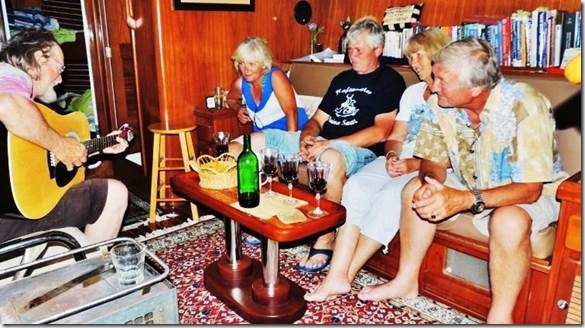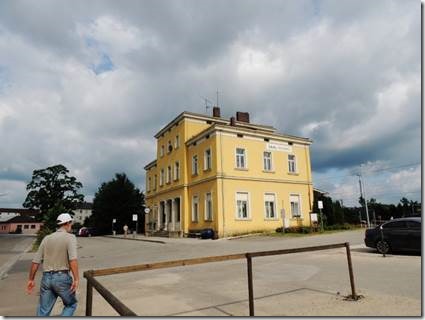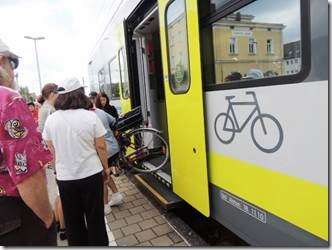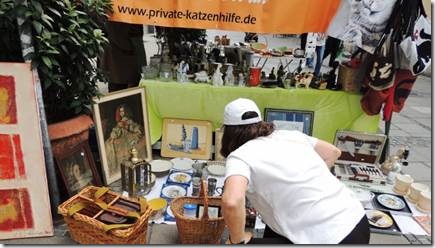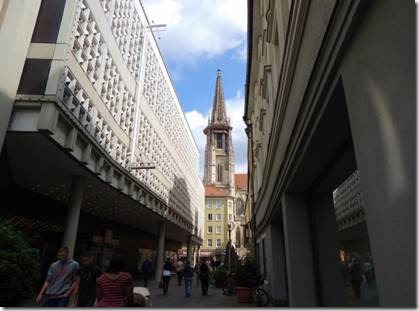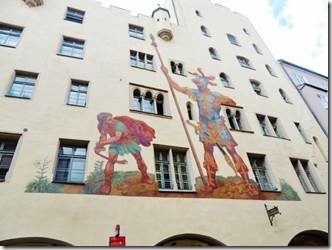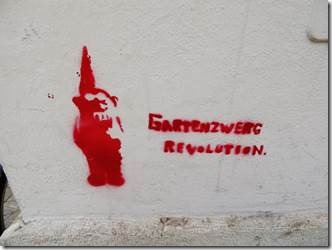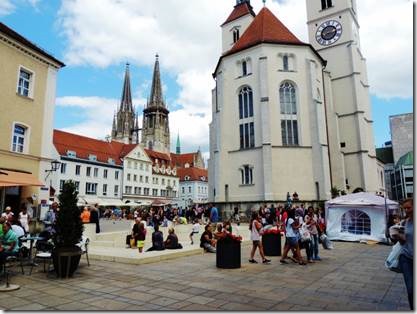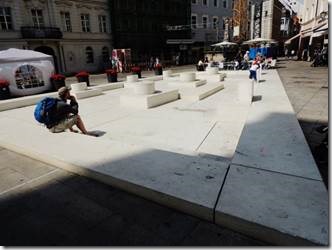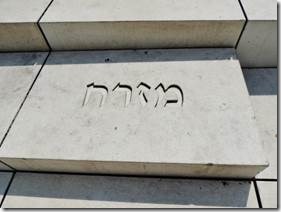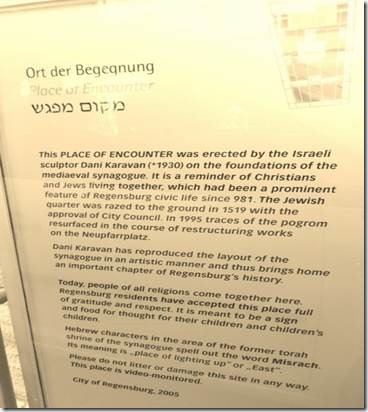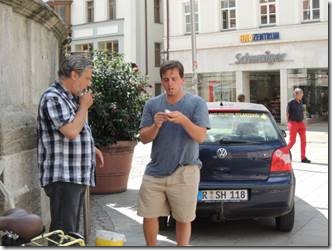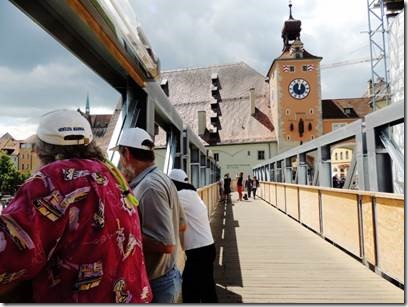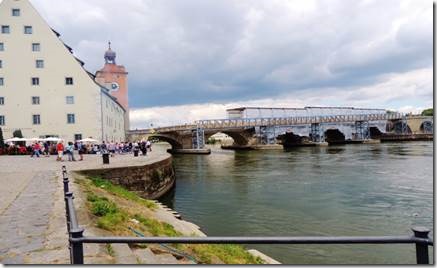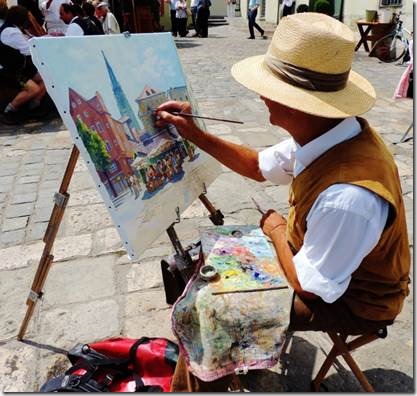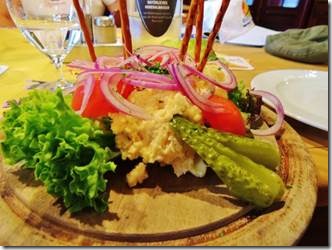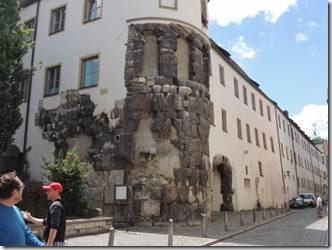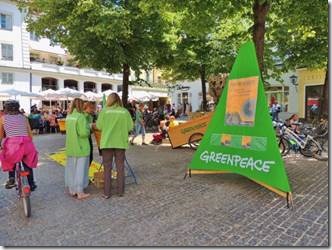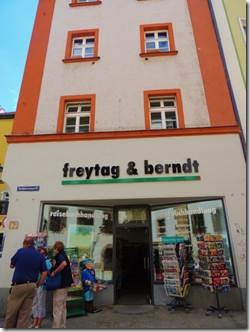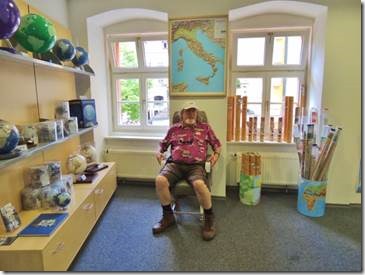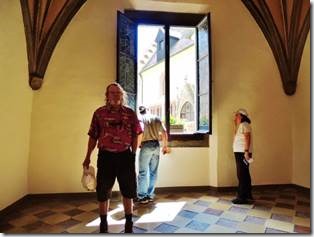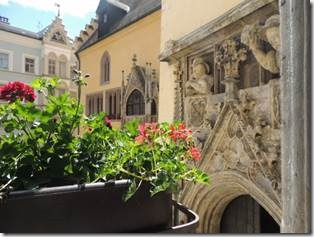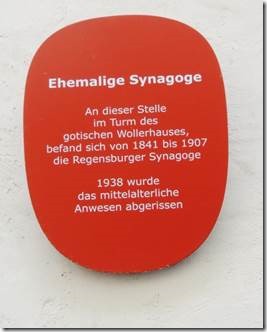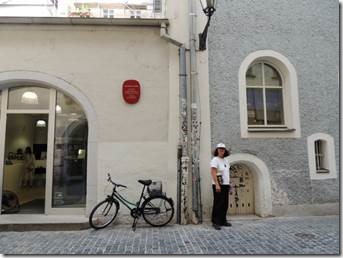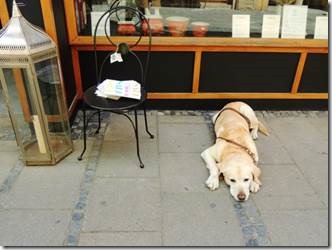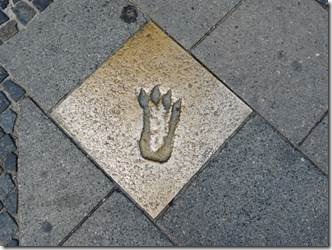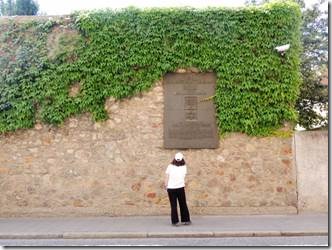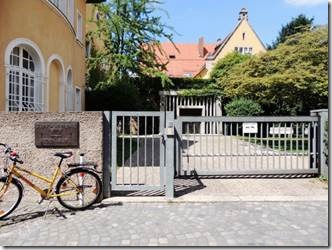NMYC Yacht Club
Deggendorf
Guten Tag,
We’ve been “stranded” in Deggendorf since the afternoon of the 16th. We had planned an overnight stop, but there’s just not enough water in the Danube for us to continue downstream. We actually scrapped bottom on our way here. Thankfully there is one visitor berth here at the NMYC Yacht Club so we have power, water and wifi! We could have been “stranded” at the previous overnight spot which was just the other side of the Schleuse Geisling. We had tied up at the entrance to the lock which was lovely but with no services such as water or power. Had we been forced to remain there for as long as we might be in Deggendorf, we’d be eating our can goods just now. If necessary we can generate our own power and make water. Thankfully it didn’t come to that because we managed to “limp” into Deggendorf. We need 2 meters of water under us to avoid scraping bottom. Right now there’s just about 2 meters in the channel if we stayed exactly in the deepest part of the river. But the river bottom for the next bit to Passau isn’t so forgiving so scraping bottom wouldn’t be a good thing.
Although there has been flooding on the Danube in Serbia, Rumania and Bulgaria, our part of the river is too dry. River traffic continues because the giant barges and cruise ships actually need less water under them. It’s only boats like ours with deep keels that have the problem.
But the grocery stores are within walking distance and the town center has coffee shops in its quaint center. So we could be doing much worse.
This email is about Reggensburg, our stop prior to Deggendorf.
Ru
|
Randal was persuaded to get out his guitar by Linda, Wolfgang, Gitty and Franc; the wonderful and helpful folks we met at Marina Saal. Our first afternoon there, Linda who is Irish by birth so of course fluent in English, arrange for Gitty to drive us to the grocery store. Later that evening, Linda and her partner Wolfgang, the marina manager and Gitty and her partner Franc came for a visit. The marina is great and the folks with boat there very friendly. We were all invited to an informal party the night of our trip to Regensberg; but only Rick and Mary, the partiers among us, took part. Randal and I were pooped and enjoyed a quiet evening on the boat catching up on email and reading. Not only was Marina Saal able to accommodate a boat our size, which Wolfgang called an “icebreaker” but there was wifi and electricity, and water and showers ….. A great place to stop along the way. |
|
Off to Regensburg by train Finding the train station in Saal was an adventure in itself…as was the way home at the end of the day. Lots of cyclist were taking advantage of bicycle transport on the trains. When my friend Martha and I toured England you had to hunt for the baggage car and then lift your pannier laden bike up almost two feet onto the train. These trains allow you to pretty much wheel your bike right on. The fun thing to do would be to take the train a certain distance from home and then bike back or visa-versa depending on the time of year and weather. |
|
Hunting for souvenirs |
|
Walking towards the old town center A Medieval Gem, Almost Lost Regensburg’s Old Town was once threatened by highway construction – By Edith Kresta http://www.atlantic-times.com/archive_detail.php?recordID=1503 http://whc.unesco.org/en/list/1155 is the UNESCO description of Regensburg which is on the World Heritage list. |
|
Regensburg: Goliath House “The ‘Goliath House’ (Goliathhaus), built in 1260, is considered one of the most well-known landmarks of Regensburg with its painting of David and Goliath done in 1573. Along with the Haus Heuport, this is the largest ‘city castle’ with in the inner city and is located on the southern base of the old roman fort. The name is likely not derived from the biblical epic, but rather from the name ‘Goliards’. Theology students were called Goliards as their guardian angel was called Golias. It is believed that the present Goliath house was built on the location of the quarters in which these traveling theology students often stayed during the 12th century. This current house would over time belong to many patrician families such as: Dollingers, Mallers and the Nuremberger family.” http://www.regensburger-touristen-guide.de/en,bauwerke,6,goliathhaus/ |
|
Garden dwarfs Revolution was painted on a wall not far from David and Goliath |
|
The former Jewish quarter in Regensburg… Memorial to the former synagogue “The Jewish quarter in Regensburg is first mentioned in a document dating from ca. 1000 A.D.. This is the earliest mention of a Jewish settlement in Germany. For over 500 years they lived here largely free of persecution and pogroms, and left their mark on the history of Regensburg. The Jewish quarter (on today’s Neupfarrplatz) comprised about 39 houses and several public buildings, including a synagogue. The community had its own administration, seal and judge. In 1196 Rabbi Jehuda ben Samuel he-Chasid came to Regensburg and founded a famous Talmud school which became the centre of Middle European Jewish live for years. By the end of the 15th century tension between Jews and Christians was beginning to increase. A few weeks after the death of Emperor Maximilian I, under whose rule Jews had enjoyed protection, the town council decided to expel all Jews from Regensburg. Therefore, in 1519, the Jewish quarter was razed to the ground and a pilgrimage chapel was built on where the synagogue used to be. Between 1995 and 1998 the most extensive excavations within the Regensburg city centre to date were carried out on this approximately 3000 m² site. In the course of these excavations the remains of cellars belonging to houses and buildings of the Jewish quarter were exposed. The most sensational find was the Gothic synagogue and the remains of the previous Romanesque synagogue. In several places the Roman layer could be investigated. With the help of the most modern technology, new knowledge about buildings techniques was gleaned, while numerous finds provided a wealth of information about everyday life in the medieval Jewish quarter. The most spectacular find made during the 1995-98 excavations dates from the end of the 14th century, when the medieval Jewish community was at its peak: A treasure trove of 624 gold coins, found not far from where the document Neupfarrplatz is located. In 2005, the Israeli sculptor Dani Karavan erected a memorial on the exact spot of the former synagogue on Neupfarrplatz. The so-called “Place of Encounter” is a reminder of Christians and Jews living together, and a reproduction of the layout of the synagogue in an artistic manner. It brings home an important chapter of Regensburg’s history. Today, people of all religions come together here. Regensburg residents have accepted this place full of gratitude and respect. It is meant to be a sign and food for thought for their children and children’s children. Hebrew characters in the area of the former torah shrine of the synagogue spell out the word “Misrach” (“place of lighting up” or “East“). |
|
The older man on the left was teaching the younger man on the right how to prepare a cigar for smoking. |
|
The Steinerne Brucke was covered with a current reconstruction project. “The Bridge Arch and the Bridge Tower are part of the city expansion at about 1320.” Bridge Tower Museum brochure. The oldest bridge left standing in Germany according to my MPM Danube guide. “The "Stone Bridge" was constructed from 1135 to 1146 in romanesque style. The bridge was originally built with 16 supporting arches giving it a total length of 330 meters. The 16th arch is now no longer visible as it was eliminated with the building of the ‘Salzstadel’ on the city-side of the bridge. The arches have a width ranging from 10 to 17 meters and are equipped with steel icebreakers on the up river points of the pillars. Originally reinforced with stone in the river bed, the pillars are now supported by cement to create the legendary ‘regensburg danube whirlpools’. In the 13th century, the bridge was equipped with 3 fortified towers. The ‘black tower’ which was located on the ‘stadtamhof’ side, was surrounded by a mote, a few smaller towers, and had a drawbridge connecting it to the north. These were torn down after heavy damage from the war in 1810. The middle tower was already unstable after ice impact in 1784, and had been removed. The only remaining tower today is the ‘bridge- or Schuldturm’ on the city or southern side. This tower is decorated with two clocks and painting depicting the 30-year Battle.Legend has it that the cathedral builder and the bridge builder had bet each other who would finish their projects first. As the construction of the cathedral began to progress much faster, the bridge builder decided to make a pact with the devil in order to win his bet. Although the devil did help him to win his bet, the bridge builder had to promise the devil the first 3 souls who would cross the bridge, and thus could not celebrate his victory in full fancy. However, a hooded monk wisely advised him to send 3 animals over the bridge first; 2 roosters and a dog were thus the first to cross the bridge. The devil was so furious that he had made a huge hole in the stone railing which could be seen for many years.” http://www.regensburger-touristen-guide.de/en,bauwerke,1,steinerne_bruecke/ “Salt is one of the oldest commodities to have been traded. Roman soldiers often received their wages in salt, hence the word “salary.” Europe’s most important 13th-century trade route brought the salt from mines in Reichenhall to Regensburg. Adjacent to the bridge is the seven-story Salt Store, where salt was traded and warehoused.” Read more: Germany’s World Heritage Sites: Wurzburg, Bamberg and Regensburg | The Hunt Magazine http://thehuntmagazine.com/ |
|
I could have stood and watched for hours. |
|
Bavarian Cheese board lunch; sort of like the Ploughman’s lunch in England: cheese, bread, pickle and onion. The cheese was a spread of maybe goat and blue, something very strong. There was enough for all of us, but Randal, Mary and Rick had their own huge meals to deal with. Luckily we did a lot of walking afterwards, including an “indirect” route back to the boat from the Saal train station. Trying different food while traveling is more than about getting enough (or at times too many) calories. Our friend Heidi’s column about food and travel tells the story best. Heidi Trautmann Column 62 – Let’s talk about culture and….. traditional cuisine 5/3/2014 |
|
“The area that is now Regensburg was the site of a 600-soldier Roman camp on a hill at the empire’s border in 90 AD. Emperor Marcus Aurelius established a stone Roman military fortification and trading post, Castra Regina, circa 179 AD. A portion of the northern Roman gate, the Porta Praetoria, is still visible.” Read more: Germany’s World Heritage Sites: Wurzburg, Bamberg and Regensburg | The Hunt Magazine http://thehuntmagazine.com |
|
Greenpeace volunteers in the town center. |
|
freytag & berndt specialize in outdoor books, maps, etc. Their chairs are discards from airplanes with seatbelts included. |
|
Town Hall building Today, after numerous additions and alterations, you can admire the three-section building complex dating from the 13th century which consists of the Town Hall tower, the Gothic Imperial Chamber building and the baroque Town Hall. From 1663 to 1806 the Perpetual Imperial Assembly met in the Imperial Chamber. It was there that the well-known expressions “to put something on the long bench” (to postpone something) and “to sit at the green table” (to take important decisions) originated. Visit the imperial assembly hall and the torture chamber in the cellar where persons charged with an offense were “questioned”. Access only with guided tour. (The English language tour wasn’t offered at a convenient time for us. ) |
|
Former Synagogue “at this point in the tower of the Gothic woller house was located from 1841 to 1907, the Regensburg synagogue in 1938 was the medieval mansion demolished” Google Translate |
|
Very patiently waiting… |
|
This symbol which reminds me of the Hebrew letter Shin (but has one too many bits on top) was around the corner from the current Jewish Cultural Center on Am Brixener Hof. Over the following centuries the community slowly grew again, and in 1912 more than 500 Jews of Regensburg were able to open their most impressive Synagogue (Am Brixener Hof 2), a building badly damaged by the Nazis 26 years later during Kristallnacht. Throughout the 1930’s the majority of Regensburg’s Jews emigrated, with the remaining members of the community suffering deportation in 1942 – from which few were to return. The Regensburg Jewish community was re-established in 1945 by Holocaust survivors, who restored the non-destroyed parts of the synagogue. During the subsequent decades, the synagogue has been significantly renovated and enlarged. The Jewish cemetery, dating from 1822, is on Schillerstrasse, on the west side of “Stadtpark”. |

